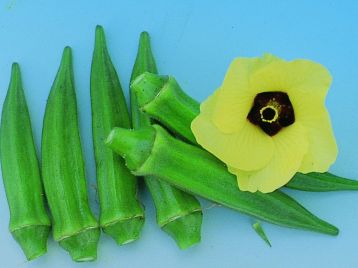Beschrijving
Cultural Tips
The OKRA is a common fruit in many countries but difficult to find in Europe, except in some stores and markets that specialize in foreign foods.
The OKRA PLANT is related to the cotton family and in a greenhouse it reminds a plant of a sweet pepper or a paprika but it is more open with more and finer branches and could grow two meter plus tall.
The OKRA fruit is a pod, it resembles a hot pepper but is not round but square and tapered from about 2,5cm. to a point and is most valuable when about 8 cm. long.
The OKRA requires a similar climate as for paprika with ideal temperatures between minimum 20 and maximum 30 degrees C. Okra prefers a light soil with a Ph. of about 6. Compact soil restricts plantgrowth of the OKRA.OF THE .
General fertilization for OKRA is with a compound of 10-2-10 and the quantities must be decided after a soiltest. Too much nitrogen will result in too lush growth, susceptable weak plants and few fruits. Soil analysis should be repeated regularly to ajust the quantities of fertilizer for best results.
The OKRA seeds have a tough skin and it is recommended to soak the seeds in luke warm water overnight before sowing to improve germination. The seeds should be treated with Thiram to prevent damping off.
After about five weeks.
Suggested plant distance for OKRA is 1 meter between the rows and 30 cm in the row, about 34000 plants per HA..
The young Okra plants are very tender so make sure not to damage the young plants when transplanting or planting out.
Must be dealt with as soon as they become visible, with the locally recommended products. Yearly crop rotation is also recommended
to reduce the need of disease control. Weeds must be kept under control from the start.
OKRA BERGSPITS F1, unlike other OKRA varieties, is resistant to Verticillium and Fusarium, which are the most important diseases in OKRA.
Harvesting can start about 50 days after planting out and could continue over a prolonged period of time, provided proper care has been taken to maintain the crop. Harvesting should be done every other day for best quality and the highest yield.
Harvesting should be done with a sharp knife and wearing gloves and long sleeves as the plants could cause an allergic reactionwith some people..s toprotect the skin of the hands from rashes. The tender OKRA fruit dries out quickly after being harvested, loosing quality.
Ideally, harvesting OKRA should be done very early in the day when temperatures are still low. The fruit should be put in a shaded and cool place immediately. Handle the OKRA fruit very carefully, bruised pods will turn brown wihin hours.
Always store in a very well ventilated place at a temperature of ca. 8 degrees C. and a relative humidity of 95%
Good quality OKRA will keep for a week or ten days. Storing in perforated packs and applying 5 to 10 % CO2 could increase shelf life with another week.
The produdction of OKRA depends of course on the skill of the grower but could be when in full production 5 kilo per 100 m2. in one picking, as part of a total possible yield of ca. 1500 kilo per 100 m.
OKRA can be used in the kitchen in many different ways, often together with tomatoes: raw in a salad or cooked in a mixed vegetable dish, on the barbecue, in a stew and also deepfried.
The OKRA is full of vitamins, minerals, and trace elements, such as: Beta carotene, B1., B2., B6., Foliumacid, Na., K., Ca., F., Mg., Fe., Sel.,Zinc.
The OKRA is claimed to have positive effects on many diseases and disorders but these claims are still to be verified.

